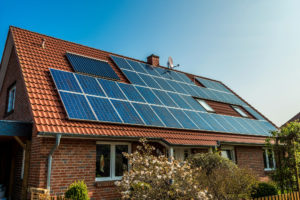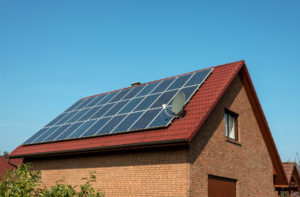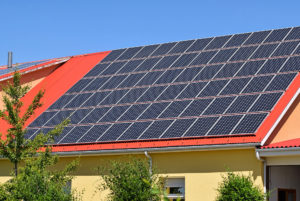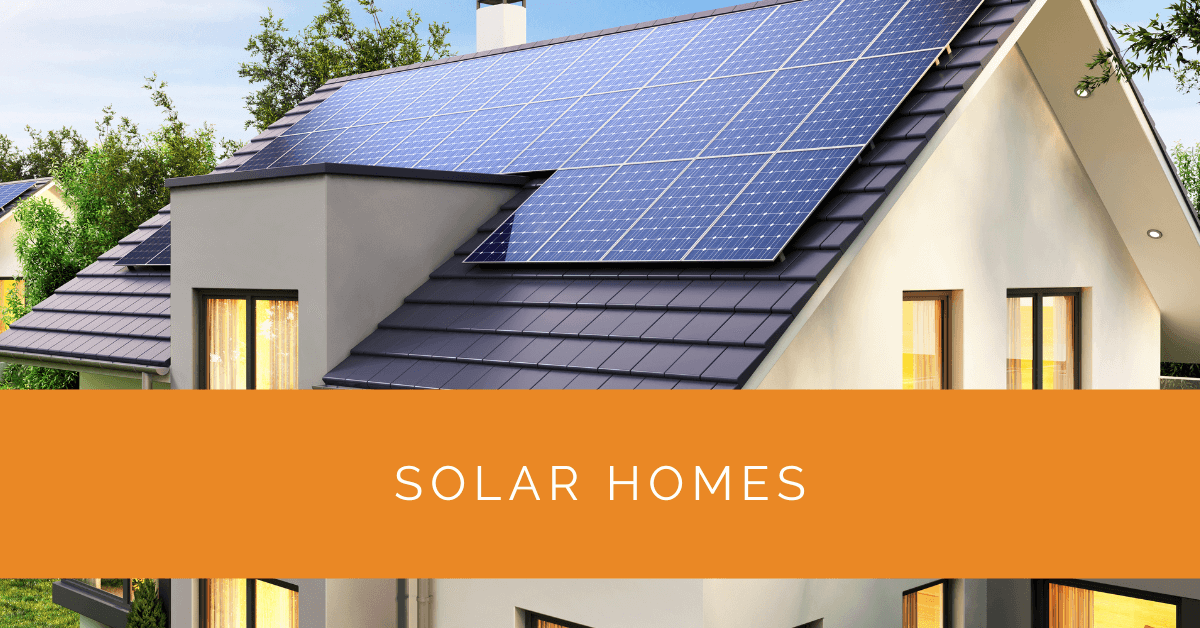Transitioning your house into a solar home reduces your reliance on traditional energy sources and offers numerous benefits, such as lower electricity bills and a smaller carbon footprint. By installing solar panels on your roof, you can tap into the abundant power of the sun to generate clean, renewable energy for your household. This comprehensive guide will walk you through making your house a solar home, from understanding how solar panels work to maximizing solar energy generation and exploring financial incentives. Get ready to embrace the power of solar energy and embark on a sustainable journey toward energy independence.
Contents
- 1 Key Takeaways
- 2 Understanding Solar Homes
- 3 Assessing Your Home’s Solar Potential
- 4 Solar Panel Installation Process
- 5 Maximizing Solar Energy Generation
- 6 Financial Incentives and Rebates
- 7 Energy Efficiency and Solar Homes
- 8 Living in a Solar Home
- 9 The Future of Solar Homes
- 10 Case Study: Transitioning to a Solar Home
- 11 Expert Insights From Our Solar Panel Installers About Making Your House a Solar Home
- 12 Experience Solar Excellence with Us!
- 13 Conclusion
Key Takeaways
- Transitioning your house into a solar home offers numerous benefits, including lower electricity bills and a reduced carbon footprint.
- Solar panels, inverters, and energy storage systems are essential components of a solar home system, providing clean and renewable energy.
- Assessing your home’s solar potential, consulting with professionals, and exploring financial incentives are crucial steps in making your house a solar home.
Understanding Solar Homes
Solar homes harness the power of the sun to generate clean and renewable energy. By installing solar panels on your roof, you can power your home with solar energy, reduce your carbon footprint, and achieve energy independence. Understanding the components of a solar home system, including solar panels and their operation, is crucial to making an informed decision.
What is a Solar Home?
A solar home is a residence equipped with a solar energy system that converts sunlight into electricity. This system typically includes solar panels, an inverter, and a connection to the electrical grid. Solar homes generate their electricity, reducing reliance on traditional utility power and promoting clean energy usage.
Benefits of Solar Homes
Solar homes offer numerous benefits, both for homeowners and the environment. Some key advantages include:
- Renewable Energy Generation: Solar homes utilize sunlight, a renewable resource, to generate electricity, reducing the dependence on non-renewable sources.
- Lower Electricity Bills: You can significantly reduce or even eliminate your monthly electricity bills by generating your electricity.
- Energy Independence: Solar homes give homeowners greater control over their energy production, reducing reliance on the utility grid and mitigating the impact of rising energy costs.
- Reduced Carbon Footprint: Solar energy is clean and produces no greenhouse gas emissions, contributing to a greener and more sustainable future.
- Long-Term Savings: Investing in a solar home offers long-term financial benefits, with potential payback periods and substantial savings over the system’s lifespan.
- Added Home Value: Solar homes can potentially increase property value, as they are increasingly sought after by homebuyers seeking energy-efficient and environmentally friendly residences.
How Solar Panels Work
Solar panels, also known as photovoltaic (PV) panels, are the primary components of a solar home system. They consist of multiple interconnected solar cells that convert sunlight into electricity. When sunlight strikes the solar cells, it creates an electric current due to the photovoltaic effect. This direct current (DC) electricity is converted into alternating current (AC) by an inverter to power the home’s electrical appliances and lighting.
Components of a Solar Home System
A solar home system comprises several key components:
- Solar Panels: These panels capture sunlight and convert it into electricity.
- Inverter: The inverter converts the DC electricity generated by the solar panels into AC electricity compatible with home appliances and the electrical grid.
- Electrical Meter: The meter tracks the electricity generated and consumed, allowing homeowners to monitor their energy production and usage.
- Electrical Panel: The panel distributes electricity throughout the home, directing solar-generated electricity to power appliances and lighting.
- Connection to the Grid: Solar homes are typically connected to the utility grid, allowing for a seamless transfer of electricity between the solar system and the grid. This enables homeowners to use grid electricity when solar production is insufficient and feed excess solar energy back to the grid.

Assessing Your Home’s Solar Potential
Before installing a solar energy system, assessing your home’s solar potential is essential. Several factors influence the viability and efficiency of a solar installation, including:
Evaluating Roof Suitability for Solar Panels
The roof is the primary location for solar panel installation. Assessing its suitability involves considering the following factors:
- Orientation: South-facing roofs receive the most sunlight throughout the day and are ideal for solar installations. East or west-facing roofs can still be viable, but they may generate slightly less energy.
- Tilt: The angle of the roof affects the efficiency of solar panels. In regions closer to the equator, optimal tilt is often close to the roof’s latitude angle. However, adjustable mounting systems can optimize panel tilt for maximum solar exposure.
- Shading: Shading from nearby trees, buildings, or structures can reduce solar panel efficiency. It’s crucial to evaluate the amount of shade the roof receives throughout the day and identify potential obstructions that could impact solar production.
Calculating Solar Energy Potential
Understanding the solar energy potential of your location helps estimate the system’s output. Factors to consider include:
- Solar Resource: Different regions receive varying amounts of sunlight. Solar energy maps and data provide information on average solar radiation in your area, aiding in determining the solar potential.
- Roof Size: The available roof area influences the number of solar panels installed and energy generation capacity.
- System Size: The desired system size depends on your energy needs, available roof space, and budget. A solar installer can help determine the optimal system size for your home.
Assessing Shading and Obstructions
Shading from trees, nearby buildings, or other obstructions can significantly impact solar panel performance. It’s essential to assess potential shading sources during different times of the year to optimize solar energy production. Trimming or removing shading objects may be necessary to ensure maximum solar exposure.
Considering Home Orientation and Tilt
The orientation and tilt of your home affect solar panel performance. South-facing roofs typically receive the most sunlight, but panels can still be installed on east or west-facing roofs. Adjustable mounting systems allow for optimal panel tilt, maximizing solar energy capture. By evaluating these factors, homeowners can determine the suitability of their roofs for solar panel installation, estimate energy production, and make informed decisions about going solar.

Solar Panel Installation Process
Once you have assessed your home’s solar potential, the solar panel installation process involves several steps:
Hiring a Professional Solar Installer
Working with a reputable and experienced solar installer is crucial for a successful installation. Research local solar companies, check customer reviews, and request quotes to find the right installer. A certified installer will efficiently handle the installation process and ensure compliance with local regulations.
Obtaining Permits and Approvals
Solar installations may require permits and approvals from local authorities. Your solar installer will assist with the necessary paperwork, ensuring compliance with building codes, zoning regulations, and grid interconnection guidelines. Obtaining permits ensures that your installation meets safety and quality standards.
Choosing the Right Solar Panels
Selecting the appropriate solar panels for your home involves considering efficiency, durability, warranty, and certification factors. Look for reputable manufacturers and consider the panel’s performance in various conditions. Consult with your solar installer to choose panels that align with your energy goals and budget.
Mounting Solar Panels on the Roof
During the installation process, solar panels are mounted securely onto your roof. The mounting system ensures stability and protects against wind and other weather elements. Your solar installer will determine the optimal positioning and alignment of the panels for maximum solar exposure.
Connecting Solar Panels to the Electrical System
After the panels are securely mounted and connected to the home’s electrical system, this involves wiring the solar panels to an inverter, which converts the DC electricity generated by the panels into AC electricity used in your home. The inverter is then connected to the electrical panel, allowing solar-generated electricity to power your appliances and lighting. Following these installation steps and working with a professional solar installer can ensure a smooth and efficient transition to solar power in your home.

Maximizing Solar Energy Generation
To maximize the generation of solar energy and optimize the performance of your solar home system, there are several strategies to consider:
Optimizing Panel Placement and Angle
Proper panel placement and angle are crucial for maximizing solar energy generation. The optimal tilt and orientation of your solar panels depend on your location and the specific characteristics of your roof. A solar installer can help determine the ideal placement to capture the most sunlight throughout the day and year.
Utilizing Solar Tracking Systems
Solar tracking systems are designed to move solar panels throughout the day to follow the sun’s path. These systems increase energy generation by maximizing exposure to sunlight. While they can enhance overall solar production, they may require additional investment and maintenance compared to fixed-mount systems.
Cleaning and Maintaining Solar Panels
Regular cleaning and maintenance of your solar panels are essential for optimal performance. Dust, debris, and dirt accumulation can reduce energy production. Clean your panels periodically, especially in areas with low rainfall or high pollution. Check for any damage or shading caused by tree branches and address issues promptly.
Monitoring Solar Energy Production
Monitoring solar energy production allows you to track system performance and identify potential issues. Many solar home systems include monitoring features that provide real-time energy generation, consumption, and savings data. Monitoring helps you ensure that your system is operating efficiently and enables you to take corrective actions if necessary.
Understanding Net Metering and Electricity Credits
Net metering is a billing arrangement that allows solar homeowners to receive credits for the excess energy they generate and feed back to the grid. During periods of low energy consumption, your solar home system can export surplus electricity to the grid, offsetting your energy consumption when solar production is insufficient. This helps reduce your electricity bill and maximize the financial benefits of your solar installation.

Financial Incentives and Rebates
Making your house a solar home often comes with financial incentives and rebates to help offset the upfront costs and accelerate your return on investment. Here are some common incentives to consider:
Government Solar Incentives and Tax Credits
Governments at the national, state and local levels often offer incentives and tax credits to promote the adoption of solar energy. These incentives can significantly reduce the overall cost of installing a solar home system. Examples include federal investment tax credits (ITC) and state-specific rebates or grants.
Local Rebate Programs for Solar Homes
Many utility companies and local organizations offer rebate programs to incentivize solar installations. These programs provide financial incentives based on the capacity of your solar system or the amount of energy generated. Research rebate programs in your area and consult with your solar installer to exploit these opportunities.
Financing Options for Solar Home Installations
Various financing options are available to help homeowners afford the upfront costs of installing a solar home system. These options include solar loans, leasing, and power purchase agreements (PPAs). Each option has advantages and considerations, so it’s important to evaluate which option best aligns with your financial goals and circumstances.
Return on Investment and Payback Period
A solar home system is an investment that offers long-term financial benefits. Calculating the return on investment (ROI) and payback period can help assess the economic viability of your solar installation. These calculations influence upfront costs, energy savings, and available incentives. A solar installer can help you estimate the financial returns and evaluate the payback period for your specific system.
Energy Efficiency and Solar Homes
Energy efficiency measures complement solar installations by reducing overall energy consumption and maximizing the effectiveness of your solar home system. Consider the following energy-efficient practices:
Enhancing Home Energy Efficiency
Improving the energy efficiency of your home helps reduce overall energy demand. Consider energy-efficient upgrades such as insulation, windows, LED lighting, and efficient appliances. These measures decrease energy consumption and can further optimize the cost-effectiveness of your solar home system.
The Importance of a Well-Insulated Envelope
A well-insulated building envelope minimizes heat transfer, reducing the need for heating and cooling. Insulation in walls, roofs, and floors helps maintain comfortable indoor temperatures and reduces energy use. An energy-efficient home with a properly insulated envelope enhances the performance of your solar home system.
Integrating Solar Power with Energy-Efficient Upgrades
You can achieve even greater energy savings by combining solar power with energy-efficient upgrades. For example, consider installing energy-efficient heating and cooling systems, smart thermostats, and advanced energy management systems. These upgrades work synergistically with solar energy, enhancing overall energy efficiency and reducing your reliance on grid power.
Smart Home Technologies for Solar Homes
Smart home technologies provide additional control and optimization of energy usage in solar homes. Energy monitoring systems, smart thermostats, and home automation allow you to manage and schedule energy consumption to align with solar production. These technologies empower homeowners to make informed decisions and maximize the efficiency of their solar home systems.

Living in a Solar Home
Once your solar home system is installed and operational, living in a solar home offers several advantages:
Understanding Electricity Consumption and Savings
With a solar home system, you can see your electricity consumption and savings. Real-time monitoring data allows you to track how much electricity your solar panels generate and how much you consume. You can significantly reduce or eliminate your electricity bills by managing your energy usage and leveraging solar production.
Managing Solar Energy Production and Usage
Optimizing your energy usage patterns can help you maximize the self-consumption of solar energy. Consider shifting energy-intensive activities like laundry or dishwashing to daylight hours when solar production is high. You can reduce your reliance on grid power by aligning your energy usage with solar generation.
Benefits of Energy Storage Systems
Energy storage systems, such as solar batteries, allow you to store excess solar energy for use during periods of low solar production or grid outages. These systems provide backup power, increase self-consumption, and enhance energy independence. Explore the benefits and considerations of energy storage options to determine if they align with your needs.
Reducing Carbon Footprint and Environmental Impact
One of the significant advantages of living in a solar home is the reduction in carbon footprint and environmental impact. By generating clean and renewable energy, you mitigate climate change and reduce greenhouse gas emissions. Embrace the opportunity to live a more sustainable lifestyle and inspire others to follow suit.
The Future of Solar Homes
The future of solar homes holds exciting possibilities as technology continues to advance and the transition to clean energy accelerates. Consider the following developments:
Advancements in Solar Technology
The solar industry continually develops new technologies to improve the efficiency and performance of solar panels. Advancements such as bifacial panels, solar shingles, and more efficient photovoltaic materials hold promise for enhanced solar energy generation in the future. Stay informed about emerging technologies and their potential impact on solar homes.
Integration of Solar Homes into Smart Grids
Integrating solar homes into smart grids enables more efficient and reliable energy management. Smart grid technologies facilitate the bidirectional energy flow, allowing solar homes to return excess solar energy to the grid when not needed. This two-way flow of electricity promotes a more balanced and resilient energy system, optimizing the utilization of renewable energy resources and improving grid stability. Integrating solar homes with smart grids also opens up opportunities for energy management systems, demand response programs, and time-of-use pricing, allowing homeowners to maximize their energy savings and contribute to a more efficient and sustainable energy infrastructure.
Community solar and shared solar programs provide access to solar energy for those who cannot install solar panels on their properties. These programs allow multiple individuals or households to collectively benefit from a shared solar installation in a nearby community or shared facility. Participants can subscribe to receive a portion of the energy generated, reducing their electricity bills and supporting local renewable energy projects.
Solar-Powered Homes as Sustainable Communities
The concept of solar-powered homes extends beyond individual residences. Entire communities are embracing solar energy to create sustainable neighborhoods. These communities integrate solar power generation, energy-efficient designs, and sustainable living practices. Solar-powered homes, combined with shared renewable energy systems, energy storage, and advanced energy management technologies, foster sustainable living, resilience, and community engagement.
Case Study: Transitioning to a Solar Home
Background
At Solar Panels Network USA, we were approached by a family interested in transitioning their suburban home into a solar-powered residence. Their primary goals were to reduce their electricity bills and minimize their carbon footprint. The family had heard about the benefits of solar energy and wanted to explore the feasibility of installing a solar home system.
Project Overview
The project involved a comprehensive assessment of the home’s solar potential, selecting the appropriate solar technology, and managing the installation process. Key considerations included roof suitability, potential shading, and the family’s energy consumption patterns.
Implementation
Assessing Solar Potential: We began with an on-site assessment to evaluate the roof’s orientation, tilt, and shading. The south-facing section of the roof was identified as the optimal location for maximum sun exposure. Using solar energy mapping tools, we estimated the potential solar energy production.
System Design and Planning: Based on the assessment, we designed a solar home system tailored to the family’s energy needs. The system included high-efficiency monocrystalline solar panels, a robust inverter, and an energy storage solution to maximize self-consumption and provide backup power during outages.
Obtaining Permits and Approvals: We managed all necessary permits and approvals from local authorities, ensuring compliance with building codes and grid interconnection guidelines. This process included detailed documentation and inspections to guarantee safety and quality standards.
Installation: The installation process involved securely mounting the solar panels on the roof using a racking system designed to withstand local weather conditions. We connected the panels to the inverter, which converts DC electricity to AC electricity for household use. The system was integrated with the home’s electrical panel, allowing seamless energy distribution.
Optimizing Performance: To maximize energy production, we employed techniques such as optimizing the panel tilt and installing monitoring systems to track energy generation and consumption in real-time. Regular maintenance schedules were established to ensure the panels remained clean and efficient.
Results
The solar home system significantly reduced the family’s electricity bills, providing substantial savings. Key outcomes included:
- Energy Independence: The family experienced a noticeable decrease in their reliance on grid electricity, especially during peak sunlight hours.
- Financial Savings: The reduction in electricity bills, combined with available tax credits and rebates, made the investment financially viable, with an estimated payback period of 5-7 years.
- Environmental Impact: The system’s clean energy production contributed to a reduction in the home’s carbon footprint, aligning with the family’s sustainability goals.
- Increased Property Value: The addition of the solar home system enhanced the property’s value, making it more attractive to potential future buyers.
Summary
This case study highlights the transformative benefits of converting a traditional home into a solar-powered residence. By conducting a thorough assessment, selecting the right components, and ensuring proper installation, Solar Panels Network USA successfully helped the family achieve energy independence and financial savings. This project underscores our commitment to providing customized solar solutions that meet our clients’ specific needs, fostering a sustainable future for all.
Expert Insights From Our Solar Panel Installers About Making Your House a Solar Home
Transforming your house into a solar home is a significant step towards energy independence and sustainability. Understanding how solar panels work and their benefits can help you make an informed decision that positively impacts both your finances and the environment.
Senior Solar Installer
Assessing your home’s solar potential is crucial for a successful installation. Factors like roof orientation, shading, and available space all play a role in determining the efficiency and effectiveness of your solar system. A professional evaluation ensures optimal energy production.
Lead Solar Technician
Maximizing solar energy generation involves not just installing panels but also considering factors like panel placement, angle, and regular maintenance. These elements are key to ensuring that your solar home system operates at peak efficiency.
Solar System Specialist
Experience Solar Excellence with Us!
Trust in Solar Panels Network USA, where our seasoned experts deliver top-quality solar solutions for homes and businesses nationwide. With a legacy of countless successful installations and a commitment to sustainable energy, we’re your reliable partner in the solar journey. Ready for a brighter, eco-friendly future? Call us now at (855) 427-0058 and harness the power of the sun!
Conclusion
Transforming your house into a solar home is a transformative step towards a sustainable future. By harnessing the power of solar energy, you not only reduce your dependence on traditional energy sources and contribute to a cleaner and greener planet. Throughout this guide, we have explored the components of a solar home system, assessed your home’s solar potential, and discussed the financial incentives and environmental benefits of going solar.
As you embark on your solar journey, it’s important to consult with a reputable solar installer to ensure a seamless installation and optimal system performance. By working with professionals, you can maximize energy production, take advantage of available rebates and incentives, and ensure your solar home system’s long-term durability and efficiency.
Embrace the power of solar energy, make your house a solar home, and pave the way for a more sustainable future. By taking this step, you not only reap the financial rewards of lower energy bills but also positively impact the environment, reduce greenhouse gas emissions, and inspire others to follow suit. Join the solar revolution and become a part of the growing community of homeowners harnessing the sun’s power for a brighter and cleaner tomorrow.
About the Author
Solar Panels Network USA stands at the forefront of solar energy solutions, driven by a team of seasoned solar engineers and energy consultants. With over decades of experience in delivering high-quality solar installations and maintenance, we are committed to promoting sustainable energy through customer-centric, tailored solutions. Our articles reflect this commitment, crafted collaboratively by experts to provide accurate, up-to-date insights into solar technology, ensuring our readers are well-informed and empowered in their solar energy decisions.

